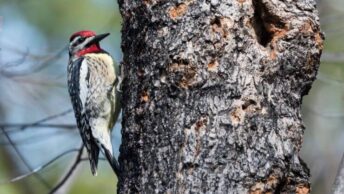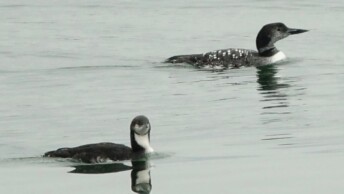Hawaii is a place where tropical beauty meets a fascinating mix of birdlife you won’t find anywhere else. While many visitors expect to see only rare native species, much of the everyday birdwatching here involves colorful and lively birds that were introduced over the past century. In parks, neighborhoods, and along the shore, you’ll notice friendly Zebra Doves walking across sidewalks, Common Mynas chattering from rooftops, and bright Java Sparrows gathering in flocks.
Even though some of these birds came from far away, they’ve become part of Hawaii’s daily rhythms. Watching them up close reveals how adaptable and resilient birds can be. This article will introduce you to some of the most common birds you’ll encounter during your stay, with tips on where to spot them and how to tell them apart. Whether you’re new to birding or just curious, there’s plenty to enjoy.
1. Zebra Dove
- Scientific name: Geopelia striata
- Life span: Up to ~10 years
- Size: 8–9 in (20–23 cm)
- Weight: 2.6–3.7 oz (75–105 g)
- Wingspan: 12 in (30 cm)
- Status: Least Concern
- State status: Breeding and common
- Migratory behaviour: Stays year-round; does not migrate.
The Zebra Dove is a graceful bird native to Southeast Asia that has become a familiar sight across Hawaii. Its delicate plumage shows soft grayish-brown feathers neatly patterned with fine black-and-white barring on the neck and chest, giving it a striped look. These doves often walk along sidewalks or rest on fences, blending easily into urban areas. Their gentle cooing adds a calming presence to parks, gardens, and beaches throughout the islands all year long.
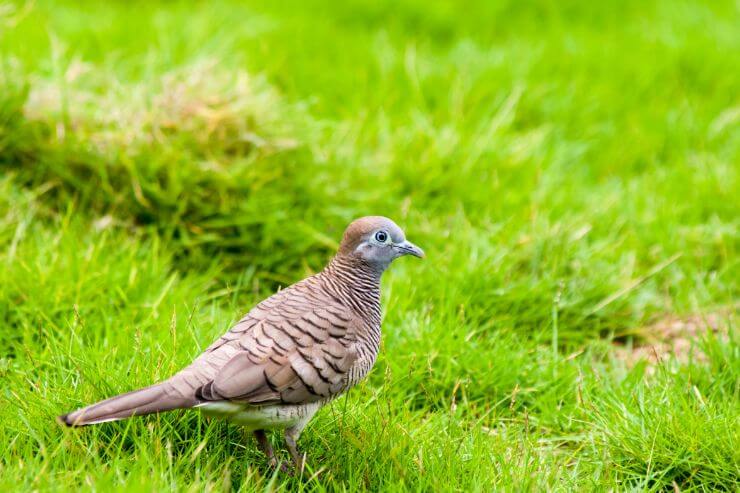
Zebra Doves build their nests in simple, exposed spots like tree branches, ledges, or even roof beams. The nest is a loose platform made from small twigs and grass. Both parents help construct it and share incubation duties. You’ll often spot them calmly sitting on their eggs, relying on their gentle colors to stay unnoticed. Their relaxed approach to nesting reflects their peaceful, quiet presence in gardens and open areas across the Hawaiian Islands.
Zebra Doves feed mostly on small seeds scattered on the ground. They walk in slow, deliberate steps as they pick at grains and tiny fallen seeds, sometimes gathering beneath picnic tables or along sidewalks where crumbs collect. Unlike some of the more assertive birds, Zebra Doves are polite foragers. They rarely compete aggressively for food, which allows them to coexist easily with other species sharing the same spaces and resources in both urban and rural areas.
Introduced to Hawaii in the 1920s, Zebra Doves adapted quickly to local habitats. Because they thrive in parks, lawns, and towns, their numbers remain strong. They have not required special conservation measures, as they maintain stable populations with little threat. Their gentle cooing has become part of the islands’ familiar background sounds, reminding people how introduced birds can blend into daily life over generations without drawing much attention to themselves.
2. Common Myna
- Scientific name: Acridotheres tristis
- Life span: Up to ~12 years
- Size: 9–10 in (23–26 cm)
- Weight: 3.9–4.9 oz (110–140 g)
- Wingspan: 17 in (43 cm)
- Status: Least Concern
- State status: Breeding and common
- Migratory behaviour: Resident all year; never migrates.
The Common Myna is native to South Asia but thrives in many Pacific islands, including Hawaii. It has chocolate-brown body feathers, a glossy black head, and bright yellow skin around the eyes that makes its face stand out. White wing patches flash clearly in flight. Mynas are highly social and often seen strutting around parking lots, lawns, and rooftops, where they call loudly and gather in lively, chattering groups throughout the day.

Common Mynas usually nest in cavities, taking over holes in trees, walls, and even gaps under rooftops. They build nests of twigs, grass, and debris, creating a bulky but secure structure. Both parents help collect materials and feed the chicks. These birds are protective and bold around the nest, scolding loudly when anyone comes too close. Their ability to use almost any nook makes them successful in crowded urban neighbourhoods and parks.
Mynas eat a wide variety of foods, including insects, fruits, scraps, and grains. They often forage on lawns, sidewalks, and picnic areas, boldly hopping around people. Their willingness to eat nearly anything helps them stay numerous and active year-round. You’ll see them pulling insects out of the grass one moment, then pecking at leftover bread the next. This flexibility is part of why they are so widespread and confident in every corner of the islands.
Introduced to Hawaii in the late 1800s to control insect pests, Common Mynas quickly spread across most islands. Over time, they have become one of the most visible birds in towns. While their numbers are secure, they have earned a mixed reputation for competing with native birds and nesting in buildings. Today, they remain common, and people continue to debate their place in Hawaii’s unique bird communities and evolving ecosystems.
3. House Sparrow
- Scientific name: Passer domesticus
- Life span: 3-5 years
- Size: 5.5-6.3 in / 14-16 cm
- Weight: 1.1-1.4 oz / 30-40 g
- Wingspan: 7.9-9.1 in / 20-23 cm
- Status: Least Concern
- State status: Breeding and common
- Migratory behaviour: Remains year-round; does not leave Hawaii.
The House Sparrow is originally from Europe and Asia and has spread almost worldwide, including Hawaii’s cities and towns. Males have warm brown backs with black streaks, gray crowns, and bold black throats. Females and young birds appear plainer, with softer brown and gray tones and lighter faces. These sparrows often gather in small flocks, perching on wires or hopping along sidewalks in search of comfortable places to rest or socialize.
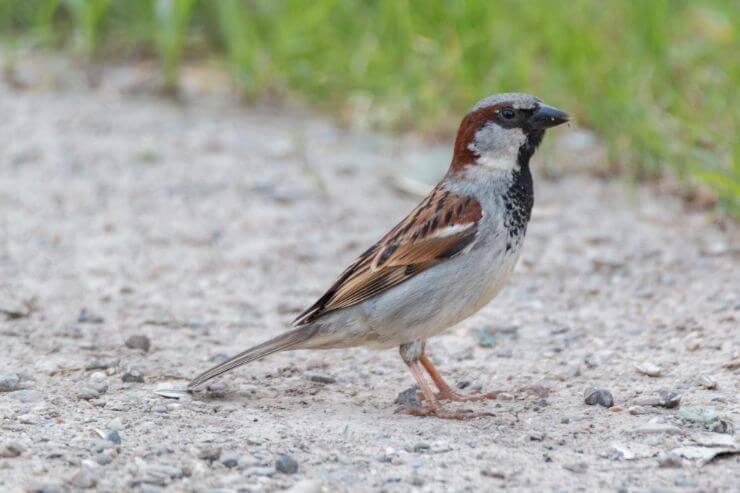
House Sparrows build nests in any small cavity they can find, from crevices under eaves to spaces inside streetlights. They pack the site with grasses, feathers, and bits of paper. Males often start the nest to attract a mate, chirping insistently nearby. Once paired, both birds finish the construction together. Because they’re so comfortable around buildings, it’s easy to spot their nests tucked neatly above doorways or hidden in small gaps around busy human spaces.
Their diet consists mainly of seeds, grains, and food scraps. House Sparrows forage confidently near people, picking up crumbs or seeds wherever they can find them. They also feed on insects, especially during breeding season when extra protein helps their chicks grow. Whether scratching in dirt patches or perching on café tables, sparrows take advantage of any opportunity, making them one of the most adaptable birds in any urban or suburban landscape.
Originally brought to North America from Europe, House Sparrows found their way to Hawaii, where they quickly established healthy populations. Because they thrive almost anywhere humans live, their numbers have stayed steady. Although they sometimes displace native species from nesting sites, there have been no major conservation programs targeting them in Hawaii. Today, they remain a familiar and often overlooked part of daily life across towns and neighbourhoods.
4. Red-vented Bulbul
- Scientific name: Pycnonotus cafer
- Life span: ~11 years
- Size: 7.5–8.3 in (19–21 cm)
- Weight: 1.1–1.4 oz (30–40 g)
- Wingspan: 12 in (30 cm)
- Status: Least Concern
- State status: Breeding and common
- Migratory behaviour: Stays in Hawaii all year.
The Red-vented Bulbul is native to South Asia and has established itself successfully in Hawaii. This bird has dark brown plumage, a slightly crested black head, and distinctive red feathers beneath the tail, which stand out whenever it moves. Its pale belly contrasts with the darker back and wings. Often spotted perched on fences or calling from treetops, the Red-vented Bulbul has become a familiar figure in suburban gardens and parks across the islands.
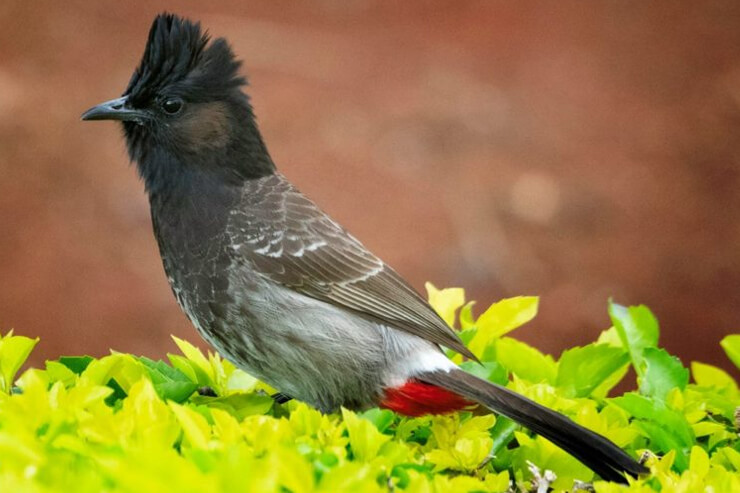
Red-vented Bulbuls nest in shrubs, trees, or occasionally man-made structures. They build cup-shaped nests woven from fine twigs, grass, and roots. The female usually selects the site and does most of the building while the male keeps watch nearby. Their nests are often hidden in dense foliage, where they raise two or three chicks. During the breeding season, bulbuls become especially vocal, chattering from perches as they defend their chosen territory from intruders.
Their diet is diverse, ranging from fruit and berries to insects and flower nectar. They eagerly visit gardens where papaya and other soft fruits grow. Bulbuls are also quick to sample cultivated plants and sometimes nibble on flowers. This wide-ranging appetite helps them flourish in Hawaii’s warm climate. Whether hopping among branches or investigating garden plots, their bold, curious nature often draws attention from people who notice their constant activity and varied foraging habits.
Red-vented Bulbuls were introduced to Hawaii in the early 1960s. Since then, they have spread widely and become established on several islands. They are sometimes considered agricultural pests because they damage fruit crops and ornamental plants. While no large-scale control programs have been fully implemented, awareness of their impact has grown. Today, they remain abundant in many urban and suburban areas where they continue to expand their presence year by year.
5. Japanese White-eye
- Scientific name: Zosterops japonicus
- Life span: 6–9 years
- Size: 4–4.5 in (10–11.5 cm)
- Weight: 0.3–0.4 oz (8–12 g)
- Wingspan: 6–7 in (15–18 cm)
- Status: Least Concern
- State status: Breeding and common
- Migratory behaviour: Year-round resident; never migrates.
The Japanese White-eye, introduced from East Asia, is a small bird that has spread widely throughout Hawaii’s forests and gardens. Its smooth olive-green back blends beautifully with leaves, while a yellow throat and breast brighten its appearance. A clean white ring around each eye makes its face instantly recognizable. These agile birds are often seen flitting among flowers and branches in quick, energetic movements that bring life to nearly any landscape.

Japanese White-eyes nest in trees and shrubs, often weaving their small cup nests on slender branches hidden by leaves. The female constructs the nest using plant fibers, moss, and spider silk to hold everything together. The nest is carefully camouflaged among foliage, making it hard to see even when close. Both parents take part in raising the chicks, visiting the nest frequently with food and remaining vigilant against any threats during the breeding season.
Their diet includes insects, nectar, and fruit. They are agile foragers, often hovering briefly at flowers to sip nectar before darting away. White-eyes pick tiny insects and spiders from leaves with quick, precise movements. Their fondness for blossoms makes them frequent visitors to flowering trees and ornamental gardens. Watching them search for food is a treat, as they flit among branches with bright eyes and constant energy, often calling in soft, pleasant notes.
Introduced to Hawaii in the 1920s, Japanese White-eyes have become one of the most widespread small birds across the islands. They have adapted easily to native forests and urban gardens alike. While they are numerous and popular with birdwatchers, their spread has raised concerns about competition with native honeycreepers. Even so, no major control measures have been widely used, and their cheerful presence remains a common sight almost everywhere in Hawaii.
6. Spotted Dove
- Scientific name Spilopelia chinensis
- Life span: Up to ~12 years
- Size: 11–12 in (28–30 cm)
- Weight: 4–6 oz (115–170 g)
- Wingspan: 17 in (43 cm)
- Status: Least Concern
- State status: Breeding and common
- Migratory behaviour: Present all year; non-migratory.
The Spotted Dove comes originally from Asia and is now common in Hawaii’s towns and open spaces. It is easily recognized by a long tail and soft brown plumage speckled with white spots on the sides of the neck, forming a partial collar. The underparts are pale, and the wings show delicate shading. These doves often gather in pairs or small groups, calmly walking across lawns or rooftops throughout the year.
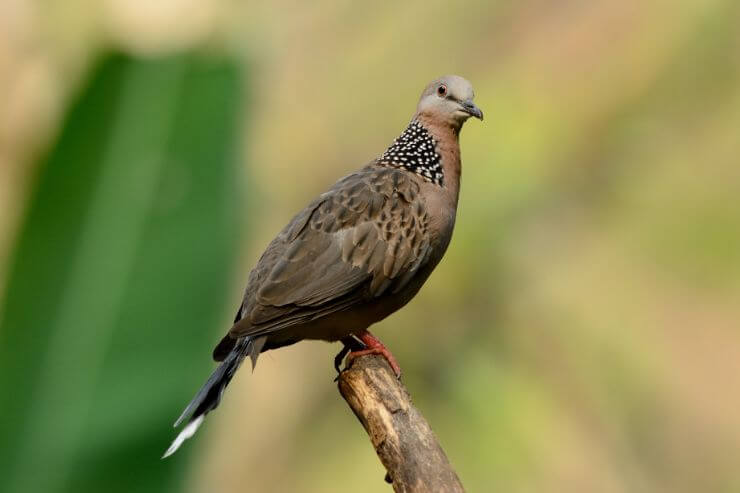
Spotted Doves build simple platform nests in trees, shrubs, or sometimes on building ledges. Both parents gather twigs, which they loosely pile together to form the base. The female usually lays two eggs, and both adults share incubation duties. Though the nest may appear flimsy, it holds together surprisingly well. During nesting season, pairs can be seen perched close together, softly cooing as they keep watch over their chosen site and stay connected as a pair.
Their diet consists mainly of seeds and grains, which they find by walking slowly across lawns and open ground. Spotted Doves often feed near roadsides and gardens, calmly pecking at scattered seeds without much concern for nearby people. They occasionally take small insects, but plant material forms the bulk of their food. Their unhurried style and gentle demeanour make them a familiar and peaceful presence wherever grass and low shrubs provide a good feeding area.
Spotted Doves were introduced to Hawaii in the 1800s and quickly adapted to local habitats. They spread throughout the islands and are now common in cities, parks, and farmlands. Unlike some introduced species, they are not considered a major problem for native birds. Because of their stable numbers and non-aggressive behaviour, there has been little need for conservation programs targeting them. They remain an easygoing part of Hawaii’s diverse bird communities.
7. Java Sparrow
- Scientific name: Padda oryzivora
- Life span: ~7–9 years
- Size: 5.5–6 in (14–15 cm)
- Weight: 0.9–1.1 oz (25–30 g)
- Wingspan: ~8.5 in (22 cm)
- Status: Least Concern
- State status: Breeding and common
- Migratory behaviour: Resident species; does not migrate.
The Java Sparrow, native to Indonesia, has become established in Hawaii and is often seen in flocks. Its appearance is striking: smooth gray plumage covers most of the body, accented by a rosy-pink belly. The large, pale pink bill looks conical and strong. A black head with bright white cheek patches makes the Java Sparrow stand out easily, whether it’s perching on a wire or moving together with others in grassy areas.
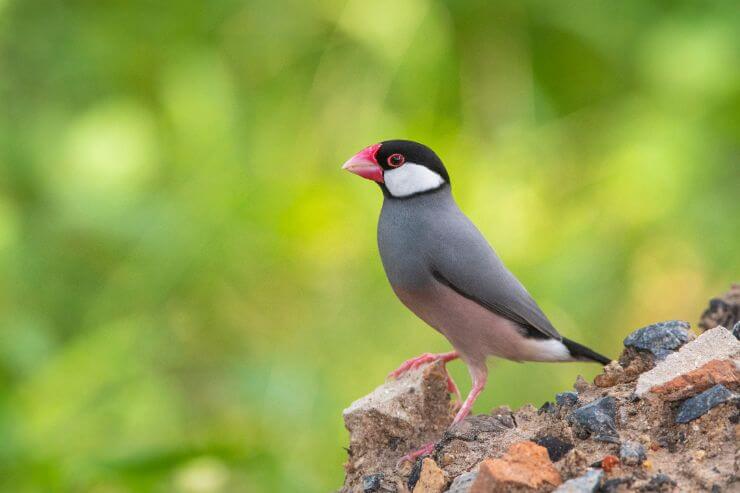
Java Sparrows nest in tree cavities, dense shrubs, or occasionally on building ledges. They gather grasses and leaves to create a thick, enclosed cup with a side entrance. Both parents share the work, arranging materials and lining the nest carefully. These sparrows often breed in small colonies, so you may see several nests clustered together. During nesting season, their soft calls and steady activity make them an unmistakable presence in neighbourhoods and parks with plenty of cover.
They feed mainly on grass seeds and grains, using their thick, conical bills to crack husks efficiently. Java Sparrows often forage on lawns and agricultural fields, sometimes gathering in large flocks to feed on fallen seeds. They also visit backyard feeders stocked with millet or similar grains. Their calm, steady foraging and social habits make them easy to spot as they move together, always alert for disturbances but otherwise quite relaxed around people.
Native to Indonesia, Java Sparrows were introduced to Hawaii in the late 1800s. They adapted quickly to life in urban areas and farmlands. Although they are listed as endangered in their native range due to trapping, Hawaii’s populations are stable. No major conservation concerns exist locally. Here, they remain a familiar and well-established species in grassy open spaces across several islands.
8. Northern Cardinal
- Scientific name: Cardinalis cardinalis
- Life span: 7-10 years
- Size: 8-9 inches (21-23 cm)
- Weight: 1.5–1.7 ounces (42–48 grams)
- Wingspan: 9.8-12.2 inches (25-31 cm)
- Status: Least Concern
- State status: Breeding and common
- Migratory behaviour: Stays in Hawaii year-round.
The Northern Cardinal was introduced to Hawaii and is now a regular sight in gardens and wooded areas. Males have vivid red plumage all over, highlighted by a pointed crest on top of the head and a black mask around the bill and throat. Females wear softer tan colors with touches of red on their wings and tails. Their strong, clear whistles carry through trees and shrubs, making them easy to hear and recognize.

Northern Cardinals build cup-shaped nests hidden in dense shrubs or small trees, weaving twigs, grass, and bark into a sturdy base. The female handles most of the construction while the male stays nearby, singing and watching for intruders. Their nests are lined with softer materials to cushion the eggs. Cardinals often raise more than one brood in a season, staying near the same territory throughout the year and returning to similar spots each spring.
Their diet includes seeds, fruits, and insects. Cardinals are frequent visitors to feeders stocked with sunflower seeds and will also forage among shrubs for berries. During the breeding season, they hunt insects to feed growing chicks. You can often see them hopping through low branches, using their strong bills to crack seeds or pick small fruits. Their bright colors stand out clearly, making them easy to notice even when quietly searching for food.
Introduced to Hawaii in the early 20th century, Northern Cardinals became a well-established resident across many islands. They adapted readily to gardens, parks, and woodland edges. Because they do not pose a major threat to native birds, no special management has been necessary. Their populations remain secure, and they are widely appreciated for their vivid plumage and rich, clear songs that brighten the landscape year-round.
9. Pacific Golden-Plover
- Scientific name: Pluvialis fulva
- Life span: ~10–12 years
- Size: 9–10 in (23–26 cm)
- Weight: 3.9–4.6 oz (110–130 g)
- Wingspan: 22 in (56 cm)
- Status: Least Concern
- State status: Migratory and common
- Migratory behaviour: Leaves in April for Alaska breeding grounds.
The Pacific Golden-Plover, known locally as Kolea, breeds in Alaska and migrates thousands of miles to winter across Hawaii’s shorelines, golf courses, and grassy fields. In winter plumage, these birds have golden-brown backs and light bellies. Breeding adults are more striking, with black faces and underparts contrasting with bright golden speckling. Their slender build and quick, alert posture make them easy to identify among other shorebirds when they arrive in autumn.
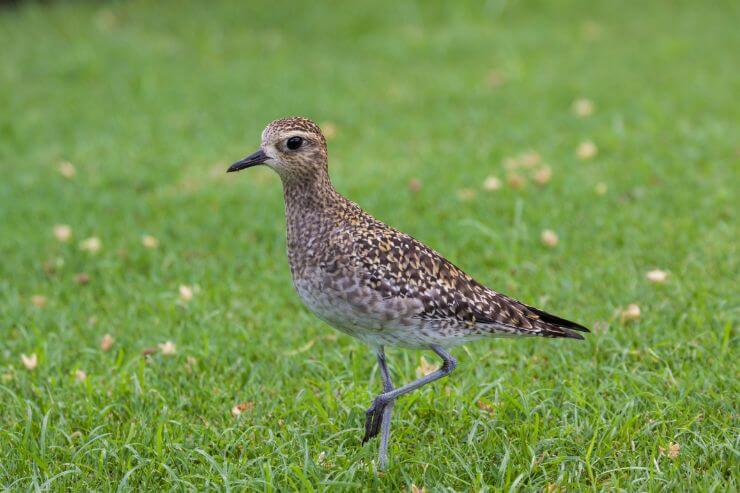
Pacific Golden-Plovers build shallow nests on the Arctic tundra during the breeding season, scraping a small hollow in the ground and lining it with lichens and moss. They nest in Alaska and Siberia, migrating thousands of miles to Hawaii each fall. In winter, they settle on golf courses, lawns, and coastal flats. Their reliable return to the same winter territories makes them familiar seasonal residents, with individuals often recognized by locals year after year.
While in Hawaii, these plovers feed on insects, small crustaceans, and worms they find by probing the soil. They walk briskly across open ground, pausing to pick up prey with quick jabs. Their keen eyesight and deliberate movements help them spot hidden food. They also eat berries and seeds occasionally. This varied diet supports them through their long stay before they return north in spring to breed on remote, windswept tundra landscapes.
Pacific Golden-Plovers are protected under international agreements that safeguard migratory birds across their range. Though their populations remain stable, habitat loss in breeding and wintering grounds is a concern. In Hawaii, they are not considered threatened. People take pride in seeing the same individuals return each year, and public awareness campaigns encourage respect for their winter territories. Overall, these plovers remain a remarkable connection between distant continents and Hawaiian shores.
10. Hawaiian Goose
- Scientific name: Branta sandvicensis
- Life span: Up to ~25 years
- Size: 24–27 in (60–69 cm)
- Weight: 3.3–5.5 lb (1.5–2.5 kg)
- Wingspan: 46 in (117 cm)
- Status: Vulnerable
- State status: Breeding and rare
- Migratory behaviour: Year-round resident; never leaves Hawaii.
The Hawaiian Goose, or Nēnē, is Hawaii’s state bird and an endemic species found only on the islands. It has a sturdy body covered in gray-brown feathers with delicate barring. A black face and crown contrast with a buff-coloured neck streaked with darker lines. Its legs are longer than those of most geese, which helps it walk easily over rugged volcanic terrain. Nēnē often gather in small family groups grazing in parks and nature reserves.
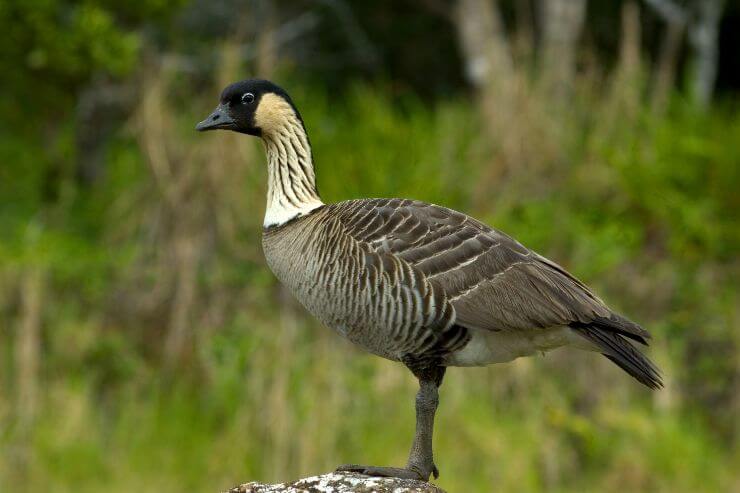
Nēnē build nests on the ground, often under native shrubs or rocky overhangs in upland habitats. Females scrape a shallow bowl and line it with down and plant material. Males guard the area closely, watching for predators. Unlike most geese, Nēnē don’t need open water to breed, and their nests may be far from ponds. This unique behaviour evolved as they adapted to life on Hawaii’s volcanic slopes and drier habitats over many generations.
Their diet is mainly plant-based, consisting of grasses, leaves, berries, and seeds from native and introduced plants. Nēnē graze slowly, walking with deliberate steps across open ground. They also pluck berries from shrubs and dig for roots. This flexible feeding behaviour helps them survive in varied habitats, from lava fields to coastal lowlands. Observers often see them calmly browsing in small family groups, their quiet presence blending into the landscape.
Once nearly extinct, Nēnē have been the focus of intense conservation efforts. Habitat loss, hunting, and introduced predators reduced their numbers to only about 30 birds by the 1950s. Captive breeding and reintroduction programs gradually rebuilt populations on several islands. Today, the species is still listed as vulnerable but has rebounded to over 2,500 individuals. Ongoing efforts continue to protect their habitat and keep this unique Hawaiian goose thriving for generations to come.
Where to look for Common birds in Hawaii
If you want to see Hawaii’s most common birds, you don’t need to go far, many are right in town, hopping along sidewalks, perching in trees, or calling from fences. Start your search early in the morning, when birds are most active and the air feels cool and fresh. Bring a pair of binoculars and a small field guide or birding app to help you identify each species by their colors and songs. Look around parks, open lawns, and gardens, where doves, mynas, and sparrows gather in groups.
One great spot is Kapiʻolani Park in Honolulu, where Java Sparrows and Zebra Doves are easy to see. Waimea Valley on Oʻahu offers trails where you can spot Japanese White-eyes flitting among flowers. Kīlauea Point National Wildlife Refuge on Kauaʻi is perfect for watching seabirds and Nēnē. For a quieter setting, try Hilo’s Liliʻuokalani Gardens, where Common Mynas and Spotted Doves blend into the peaceful scenery.
Take your time and move slowly. The more you look and listen, the more you’ll notice little details, like a flash of white under a wing or a gentle cooing sound that tells you exactly who’s nearby. It’s pretty wild how much you can notice when you really pay attention.
Conclusion
Hawaii’s common birds bring life and color to every corner of the islands, from quiet gardens to busy sidewalks. Whether you’re watching a curious myna strut across a lawn or spotting a golden-plover returning for winter, each bird has a story to share. Learning about their habits and history helps us appreciate how they’ve shaped daily life here. By paying attention, you’ll discover just how much beauty surrounds you in even the most familiar places.

